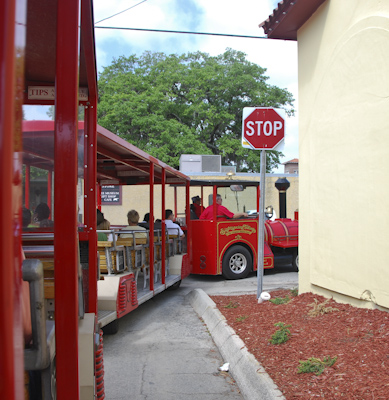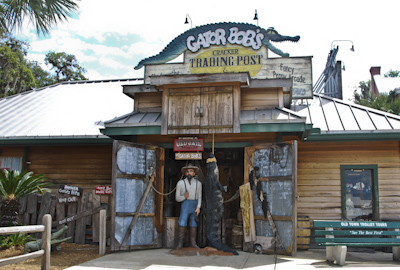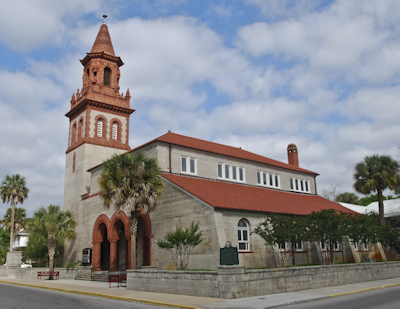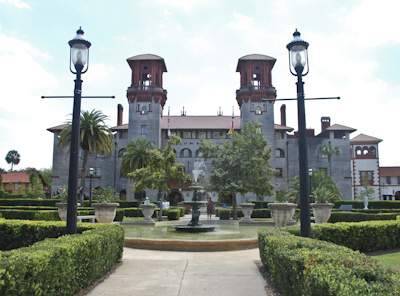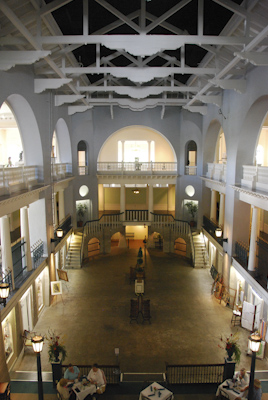Thursday, April 7, 2011
When I’m traveling and the decision has been made to stay another day, I have a strong feeling of relief to know that I don’t have to “get up and out” the next day. Most mornings, it’s comforting to hit the road and keep going. However after several days of traveling, Newton’s law of the body in motion, breaks down and I have to stop. I was very relieved to stay in St. Augustine another day to see the sights.
 Sunrise Over St. Augustine, Fl.
Sunrise Over St. Augustine, Fl.
St. Augustine is a fun place to explore because there is a lot to see and do for different people with many interests and a range of ages. We both hate run-of-the-mill gaudy tourist traps, and there certainly are enough places here for people who enjoy cheap thrills. There is a Ripley’s Believe It Or Not Museum and the Fountain of Youth attraction, both of which we avoided. At first glance, the city looked disappointing, but as we explored, we uncovered the layers of history, art, and entertainment.
 The Main Pedestrian Street in the Morning
The Main Pedestrian Street in the Morning
We quickly discovered that the tourists in St. Augustine get a late start because we were the only visitors on the empty streets and alleys. Our goal this morning was Schmagel’s Bagels for breakfast. The little cafe received good reviews on Urban Spoon. It was a good surprise to have decent bagels so far from home.
 Old Pharmacy Tourist Attraction
Old Pharmacy Tourist Attraction
We had the whole day to explore St. Augustine, so we decided to take one of the two trolleys that we saw driving around town. We have found in the past that this is frequently a good way to relatively quickly see all the main sights, then return to the ones which we want to see in depth.
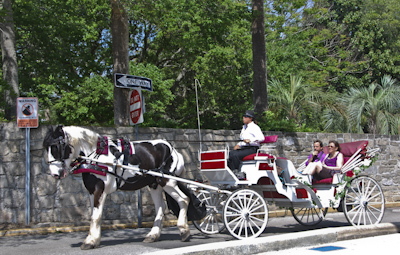 Another Way to See St. Augustine
Another Way to See St. Augustine
We walked to the end of the street to compare tourist trolleys. At the corner was an old pharmacy complete with wooden cabinets filled with old-fashioned herbal remedies.
The old pharmacy was in an brown wooden building which also housed a small snack bar, gift shop, and sold tickets for one of the trolleys. We chose the red trolly although both were “hop-on hop-offs” and their schedules were very similar. We sat on the trolley for the entire tour which took about 90 minutes. We say many sights which we would have missed without the trolley and learned where they were so we could return later.
It was fun to sit on the silly trolley and see the attractions in St. Augustine. The driver pointed out the main tourist sights punctuating his script with a good sense of humor and we enjoyed the tour. St. Augustine seemed to have many interesting places to visit for people of all ages and a wide variety of interests.
Of course there were many places to which we did not want to return. Ripley’s Believe It Or Not and The Fountain of Youth did not call to either of us. Most importantly, we learned about Henry Morrison Flagler and how he began the development of Florida and opened the entire state for all the future generations of “Floridians” and Snowbirds.
Henry Morrison Flagler had been John D. Rockefeller’s partner at Standard Oil and a railroad pioneer. Need I say more? Like many of those early robber barons, Flagler had the golden touch and made money wherever he ventured. He discovered the warm weather in Florida and built a railroad and several hotels in St. Augustine to make it easier for his wealthy friends to enjoy good weather in the winter.
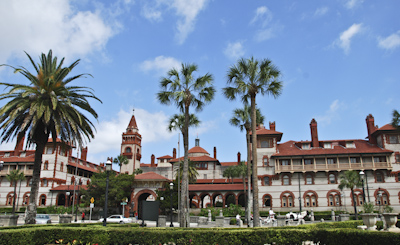 Main Entrance to Flagler College
Main Entrance to Flagler College
Poured concrete had been newly perfected and Henry Flagler also owned several concrete companies. His hotels were built with steel supports and poured concrete and were the most magnificent hotels at the time. They had electric lights, the first elevators, modern plumbing, and the most luxurious accommodations in 1887, when it opened as the Hotel Ponce de Leon. Electricity had been provided by generators supplied by Flagler’s friend, Thomas Edison. When it opened, the hotel was the first major poured-concrete structure and one of the first buildings to have electricity in the United States. Today, the building and grounds of the hotel are part of Flagler College.
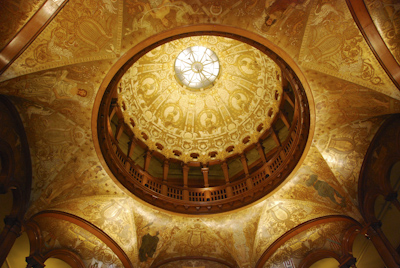 Interior of the Rotunda in Flagler College
Interior of the Rotunda in Flagler College
Many rich and famous people stayed at the Hotel Ponce de Leon over the years. We were told that the windows in the dining room were designed by Louis Comfort Tiffany. The beautiful murals in the rotunda which rises in the former lobby of the hotel, was painted by the artist, George W. Maynard. The college did have a regularly scheduled tours of the campus, but they didn’t work out for us.
Right across the street from Flagler College is the former Hotel Alcazar, which was also built by Henry Flagler in 1887 in the Spanish Renaissance style. Both hotels were designed by the architectural team of Carrere & Hastings, who later designed the New York Public Library and the U.S. Senate office building. The former luxury hotel was purchased by the Chicago publisher, Otto C. Lightner in 1946 to keep his “collections”.
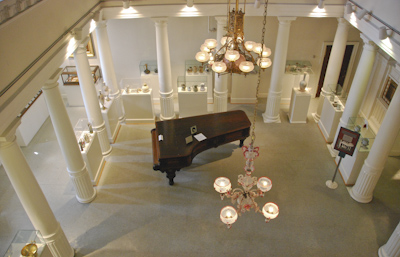 Interior Room in the Lightner Museum
Interior Room in the Lightner Museum
Today, the Lightner Museum is an incredible place to visit and to see his unbelievable collection of decorative arts. There are paintings, glassware, statues, lamps, silver, appliances, furniture, mechanical musical instruments, toys, stuffed animals, rocks, chandeliers, jewelry, and even an Egyptian Mummy.
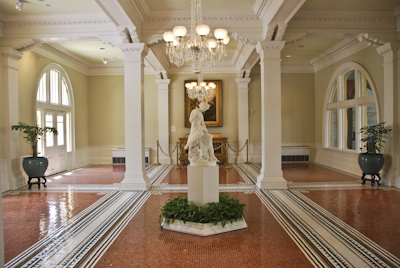 Entrance to The Lightner Museum
Entrance to The Lightner Museum
Lightner’s collection was amazing and it was also interesting to see the interior of the former hotel. When you look beyond the collection, visitors could imagine the opulence of the Hotel Alcazar. The entrance to the museum was the former lobby and the floor tiles glistened! It is worth looking at the museum’s website and seeing the UTube video of the collection and the building.
Part of the former pool had been filled in and transformed into a restaurant. The large three-story “room” had been built with a retractable ceiling so swimmers could see the beautiful blue Florida sky while swimming. We were told that Otto Lightner had purchased entire houses of wealthy people and all the contents to build his collection. This probably explains the inclusion of buttons and cigar bands in his vast collection.
There was more to see in St. Augustine, but we ran out of time because all the tourist attractions closed promptly at 5:00 PM. So after a full day of sight-seeing we still had to see the Dow Houses. We decided to visit them tomorrow morning before we left town. St. Augustine turned out to be more interesting than we expected, which is always a good thing.

